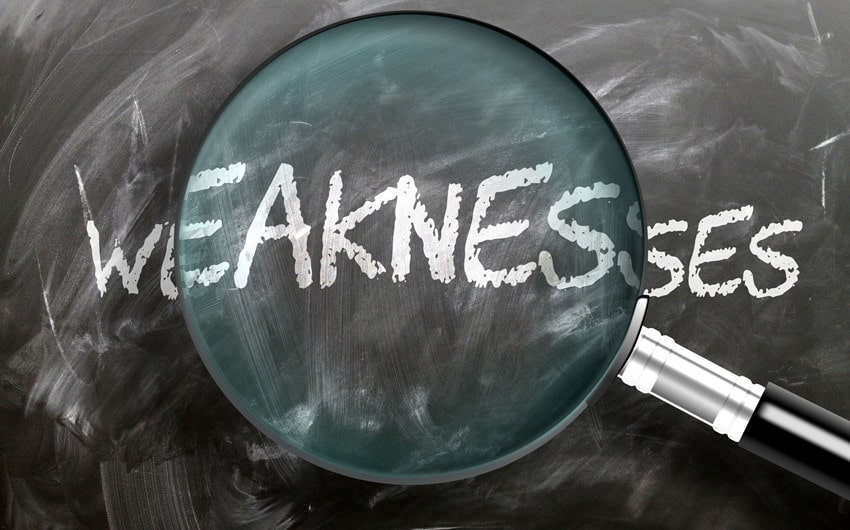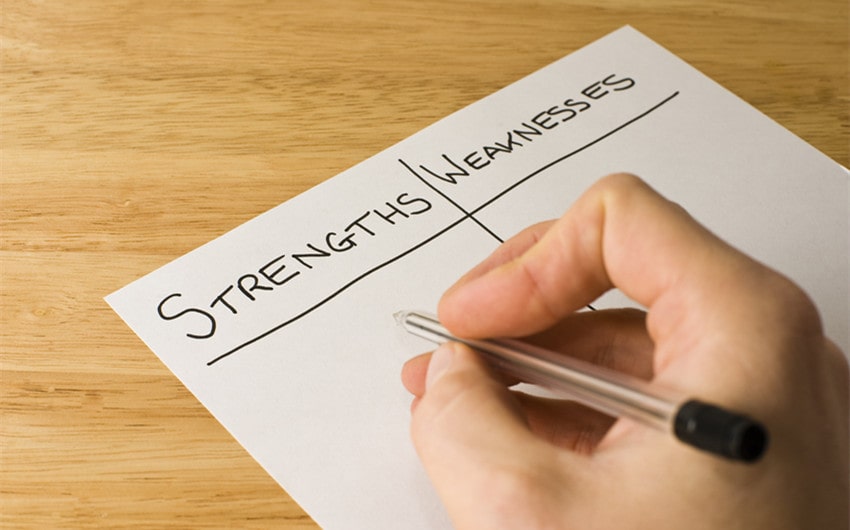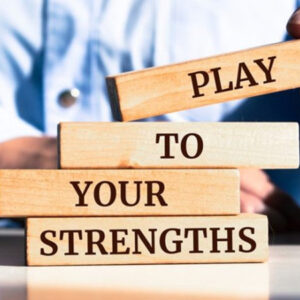
Navigating the intricacies of personal growth involves acknowledging and comprehending our personal weaknesses. This exploration is as essential as celebrating our strengths, facilitating a comprehensive understanding of our personality.
This article will delve into an organized list of personal weaknesses, illuminating their implications on various life areas and providing strategies for improvement.
What are Personal Weaknesses?
Personal weaknesses are distinct from flaws—they are areas of our life and character that can be improved with conscious effort, while flaws are inherent and often unchangeable. These weaknesses can affect personal, professional, and social aspects of life, hindering our potential for success and fulfillment. A common misconception is equating personal weaknesses with failure, but weaknesses are simply opportunities for growth.
List of Common Personal Weaknesses

Each individual’s weaknesses are unique, but some are more prevalent. Here is a comprehensive list of common personal weaknesses across different categories:
Communication Weaknesses
1. Poor listening skills: Ignoring or misinterpreting what others say.
2. Difficulty expressing thoughts: Struggling to convey ideas effectively.
3. Ineffectiveness in non-verbal communication: Misusing body language or facial expressions.
4. Shyness: Avoiding interactions due to discomfort or anxiety.
5. Over-talkativeness: Dominating conversations without allowing others to participate.
Emotional Intelligence Weaknesses
1. Difficulty empathizing with others: Struggling to understand or share others’ feelings.
2. Difficulty managing and expressing emotions: Failing to control or articulate one’s feelings.
3. Inability to handle criticism: Taking feedback personally and reacting defensively.
4. Overly emotional: Allowing emotions to disrupt reasoning and judgment.
5. Lack of motivation: Having a hard time finding the drive to accomplish tasks.
Time Management Weaknesses
1. Procrastination: Putting off tasks until the last minute.
2. Difficulty prioritizing tasks: Struggling to identify which tasks are most important.
3. Lack of punctuality: Frequently arriving late or missing deadlines.
4. Poor organization skills: Having difficulty keeping personal or work spaces tidy and organized.
5. Inability to delegate: Taking on too much responsibility instead of dividing tasks.
Decision-Making Weaknesses
1. Indecisiveness: Struggling to make decisions quickly and confidently.
2. Impulsivity: Making hasty decisions without sufficient thought.
3. Lack of critical thinking: Struggling to analyze and evaluate issues objectively.
4. Overthinking: Spending excessive time contemplating decisions or situations.
5. Fear of risk-taking: Avoiding new opportunities due to fear of failure or uncertainty.
Interpersonal Weaknesses
1. Difficulty in building or maintaining relationships: Struggling to establish and nurture meaningful connections.
2. Lack of teamwork and collaboration skills: Having difficulty working effectively in a group.
3. Over-dependence or co-dependence: Relying excessively on others for emotional or practical support.
4. Lack of assertiveness: Struggling to stand up for oneself or express differing opinions.
5. Difficulty with conflict resolution: Avoiding or struggling to manage disputes effectively.
It’s important to note that everyone has weaknesses, and recognizing them is the first step towards self-improvement. No one is expected to be perfect, and each of these areas provides an opportunity for growth and development.
Self-Assessment of Personal Weaknesses

Recognizing and acknowledging one’s personal weaknesses is an essential step in personal growth. This process requires self-awareness and honesty to accurately identify areas of potential improvement. Here are some methods that can assist in this process:
Self-Reflection Exercises
This method involves taking time to introspect and examine one’s behaviors, thoughts, and emotions. It could involve writing in a journal, meditating, or just quiet thinking. Questions to guide this process might include: What situations make you feel uncomfortable or incompetent? In which areas do you feel you are not reaching your potential? This process helps you gain valuable insights into your personal weaknesses and sets the stage for improvement.
Seeking Feedback from Others
Feedback from other people can provide an external perspective on your strengths and weaknesses. Trusted friends, family members, colleagues, or mentors can offer constructive criticism and provide insights into areas you might overlook. Remember, the goal isn’t to compare yourself to others, but to gain insights from their perceptions of you. Be open to their feedback, but also consider their perspectives in the context of their relationship with you and their own biases.
Psychological Assessments or Personality Tests
These tools can provide a structured framework for understanding your personality traits, behaviors, and tendencies. Tests like the Myers-Briggs Type Indicator (MBTI), the Big Five personality test, or StrengthsFinder can offer insights into your strengths and weaknesses. While these tests shouldn’t be the sole basis for your self-assessment, they can serve as a helpful starting point.
Analyzing Past Experiences and Failures
Your past can be a great source of learning. Looking back at past failures or situations where you could have done better can help identify personal weaknesses. It’s important to approach this method without self-judgment or regret, but rather view it as a learning opportunity.
Self-assessment can be challenging due to biases that often influence self-perception, like the Dunning-Kruger effect, where people with low ability at a task overestimate their ability. Therefore, it’s crucial to approach self-assessment with a commitment to honesty, openness, and a willingness to improve.
List of Personal Strengths and Weaknesses for Job Interviews

A comprehensive understanding of your personal strengths and weaknesses can significantly influence your job interview performance. Honest self-assessment helps you prepare for common interview questions like “What are your strengths?” or “What are your weaknesses?”. It’s crucial to tailor your strengths to the job requirements, provide concrete examples of demonstrated strengths, and balance confidence with humility when discussing them.
Examples of Common Strengths for Job Interviews
Here are some strengths that are commonly valued in the workplace:
1. Adaptability: Ability to adjust to new situations and changes in the work environment.
2. Leadership: Ability to guide, inspire, and influence others towards a common goal.
3. Problem-Solving: Skill in finding solutions to complex issues or challenges.
4. Teamwork: Ability to collaborate effectively with others and contribute to a collective effort.
5. Communication: Proficiency in conveying information and ideas clearly and effectively.
6. Technical skills: Possessing specific skills related to the job, like coding for a software developer role or data analysis for a research position.
Examples of Common Weaknesses for Job Interviews
Choosing weaknesses to share in an interview is a delicate process. The goal is to select weaknesses that are genuine but not detrimental to your ability to perform the job. Here are some examples:
1. Public Speaking: While many jobs don’t require this skill, if they do, mention how you’re actively working to improve it.
2. Patience: If your role doesn’t involve customer service or extensive teamwork, it might be safe to admit you sometimes become impatient but are learning strategies to manage it.
3. Perfectionism: Although it’s often seen as a “safe” weakness, it’s important to explain how it could hinder productivity and discuss your efforts to balance quality with efficiency.
4. Taking on too much: This shows you’re ambitious but can struggle with delegation or saying no. Be sure to mention how you’re learning to prioritize and balance tasks better.
Examples of Strengths and Weaknesses for Different Roles and Industries
Software Development
- Strengths: Attention to detail, problem-solving skills, logical thinking, continuous learning (keeping up with new programming languages or technologies), and team collaboration.
- Weaknesses: Overly perfectionistic (spending too much time on minor details rather than meeting deadlines), difficulty in explaining technical details to non-technical colleagues, or possibly focusing too much on one coding language or technology.
Sales and Marketing
- Strengths: Excellent communication skills, persuasive ability, creativity, resilience (especially facing rejection in sales), and customer orientation.
- Weaknesses: Overly competitive nature (leading to issues with team collaboration), difficulty in handling rejection, or a tendency to overpromise and underdeliver.
Education/Teaching
- Strengths: Patience, communication skills, adaptability (to different learning styles), empathy, and lifelong learning.
- Weaknesses: Difficulty in maintaining work-life balance (spending too much time on lesson planning or grading), being overly patient (allowing classroom disruptions to persist), or difficulty adapting to new education technologies.
Project Management
- Strengths: Organization, leadership, risk management, communication skills, and ability to work under pressure.
- Weaknesses: Difficulty in delegating tasks, tendency to micromanage, struggle with change (e.g., changing project scope or resources), or difficulty communicating bad news (such as project delays).
Healthcare (e.g., Nursing, Doctor)
- Strengths: Empathy, resilience, attention to detail, ability to work under pressure, and excellent communication skills.
- Weaknesses: Difficulty maintaining work-life balance (due to long hours or emotional toll of work), struggle with handling loss or grief, or reluctance to seek help or support due to the culture of self-reliance in healthcare.
Finance and Accounting
- Strengths: Attention to detail, analytical skills, problem-solving, integrity, and organization.
- Weaknesses: Perfectionism (that could slow down productivity), difficulty in communicating complex financial concepts in layman’s terms, or struggling with work-life balance during peak fiscal periods.
Human Resources
- Strengths: Excellent communication skills, empathy, decision-making skills, ethical standards, and conflict resolution skills.
- Weaknesses: Difficulty in maintaining professional distance (getting too personally involved in employees’ problems), being overly sensitive to criticism (given the frequent need to make tough decisions), or struggling to navigate office politics.
Design (Graphic, UX/UI)
- Strengths: Creativity, attention to detail, user empathy, adaptability (keeping up with design trends), and technical skills (such as proficiency in design software).
- Weaknesses: Struggle with receiving feedback on their designs, perfectionism that can delay project completion, or difficulty in explaining design choices to non-design colleagues.
Engineering
- Strengths: Problem-solving skills, analytical thinking, creativity (especially for designing solutions), teamwork, and practical technical skills.
- Weaknesses: Overly analytical mindset (which may impede decision-making), communication skills (particularly with non-technical colleagues), or struggling with the fast pace of technological advancements.
Customer Service
- Strengths: Empathy, patience, excellent communication skills, problem-solving, and adaptability (dealing with various customer personalities).
- Weaknesses: Difficulty in handling difficult customers, struggling to maintain patience, or tending to take customer complaints personally.
Entrepreneurship
- Strengths: Adaptability, resilience, leadership, creativity, and problem-solving.
- Weaknesses: Difficulty in delegating tasks, tendency to micromanage, struggling with work-life balance, or taking business setbacks personally.
Data Analysis
- Strengths: Attention to detail, logical thinking, problem-solving, communication skills (explaining data), and continuous learning (keeping up with new data tools and technologies).
- Weaknesses: Difficulty in explaining complex data to non-technical colleagues, becoming overly engrossed in data and neglecting the big picture, or overly relying on a particular tool or methodology.
Non-Profit Work
- Strengths: Empathy, resilience, adaptability, communication skills, and grant writing.
- Weaknesses: Difficulty in handling the emotional toll of the work, struggling with work-life balance due to the demanding nature of the sector, or having high expectations that could lead to burnout.
Journalism
- Strengths: Excellent communication skills, curiosity, resilience (particularly to rejection or criticism), attention to detail, and ethics.
- Weaknesses: Difficulty in maintaining work-life balance, struggling to remain objective in emotionally charged stories, or becoming too emotionally involved in a story.
Research and Academia
- Strengths: Critical thinking, problem-solving, lifelong learning, communication skills (for presenting research), and grant writing.
- Weaknesses: Difficulty in handling rejection (e.g., paper rejections, unsuccessful grant applications), struggling with work-life balance, or dealing with the pressure to publish regularly.
It’s important to remember that these strengths and weaknesses are examples and won’t apply to everyone in these roles or industries. Strengths and weaknesses can be very personal and should ideally be identified through introspection and self-assessment.
When preparing for an interview, it’s essential to consider the specific demands and characteristics of the role and industry you’re targeting. Aligning your strengths and weaknesses to these demands can help you provide tailored, compelling responses.
6 Strategies to Appropriately Discuss Personal Strengths in Interviews

Discussing personal strengths in a job interview requires tact and preparation. The key is to be honest, concise, and to back up your strengths with tangible examples. Here are some strategies to consider:
1. Align Your Strengths with Job Requirements
Before the interview, thoroughly review the job description and identify which of your strengths align with the role’s requirements. For example, if the job requires strong leadership skills and you have experience leading a team project, this is a strength you should highlight.
2. Use Concrete Examples
Instead of just stating your strengths, illustrate them with specific examples from your past experiences. For instance, if one of your strengths is problem-solving, you might share a story about a difficult situation you faced and how you found a successful solution.
3. Maintain a Balance Between Confidence and Humility
It’s important to confidently articulate your strengths, but avoid sounding arrogant. Use objective facts to describe your strengths and acknowledge the role of others, if applicable, in your success stories.
4. Avoid Generic Strengths Without Examples
Statements like “I’m a hard worker” or “I’m highly motivated” are quite generic and do not make you stand out unless they are backed up by compelling examples or stories.
5. Practice Your Responses
Like any other part of the interview, discussing your strengths should be practiced. This can help ensure your delivery is smooth, concise, and confident.
6. Show Enthusiasm
Your strengths are things you should be genuinely excited about. When you discuss them, let your enthusiasm show. This not only makes your response more compelling but also helps to show that you’re passionate about what you do.
6 Tips for Addressing Personal Weaknesses in Interviews

Discussing personal weaknesses in an interview can be challenging. You want to present yourself in the best light, but also demonstrate honesty and self-awareness. Here are some tips for effectively addressing personal weaknesses:
1. Choose Relevant Weaknesses
Discuss weaknesses that are relevant to the professional context but not detrimental to the job role you’re applying for. For instance, if you’re applying for a role as a graphic designer, it’s safer to admit you’re not great at public speaking than confessing to lacking creativity.
2. Show You’re Proactive About Improvement
Highlight your strategies for overcoming the weakness. This could be through additional training, self-study, or seeking mentorship. This demonstrates not only your self-awareness but also your commitment to personal growth.
3. Be Honest But Don’t Overshare
While honesty is essential, avoid sharing personal details that aren’t relevant to the job. Focus on weaknesses that you have recognized and are addressing, which also have a professional context.
4. Use the “Sandwich” Method
This method involves sandwiching a weakness between two strengths. Start with a strength, follow up with a weakness, and then conclude with another strength or a description of how you’re overcoming that weakness.
5. Practice Your Response
As with strengths, rehearsing your answer can ensure you sound confident and articulate during your interview. Practicing can also help you gauge the length of your response and ensure you stay on topic.
6. Be Authentic
Lastly, be authentic in your responses. Interviewers are often adept at discerning rehearsed, insincere responses from genuine ones. Authenticity can go a long way in creating a positive impression.
Addressing weaknesses in interviews can be intimidating, but with thoughtful preparation, you can turn this tricky question into an opportunity to showcase your self-awareness, honesty, and commitment to personal growth. By leveraging these strategies, you can effectively communicate your personal strengths in a job interview, making a positive impression on the interviewer and increasing your chances of success.
Transforming Weaknesses into Strengths

Recognizing personal weaknesses is the initial step, but the transformative journey occurs when one actively works towards turning these weaknesses into strengths. This process is not just beneficial but can significantly elevate one’s personal and professional life. Here are some strategies to facilitate this transformation:
1. Developing New Habits
Replacing ineffective behaviors with more beneficial ones can help overcome weaknesses. For example, if poor time management is a weakness, incorporating techniques such as the Pomodoro Technique or the Eisenhower Box can help. Habit formation takes time, so it’s crucial to be patient, consistent, and persistent.
2. Seeking Professional Help
Coaches, therapists, or mentors can provide guidance and techniques to help you work through and overcome your weaknesses. These professionals can provide an objective perspective and expert strategies tailored to your specific needs. Whether it’s a life coach to help with decision-making or a speech therapist to aid in communication, professional assistance can accelerate your improvement journey.
3. Continual Learning and Self-Improvement
Taking courses, attending workshops, or reading relevant books can provide the knowledge and tools to overcome personal weaknesses. Online platforms like Coursera, Udemy, and LinkedIn Learning offer courses on a wide array of topics. Continuous learning not only helps to overcome weaknesses but also equips you with new skills.
4. Practicing Mindfulness
Mindfulness involves being present and fully engaged in the current moment. It can help one become more aware of their behaviors, thoughts, and emotions that contribute to their weaknesses. Mindfulness exercises such as meditation and mindful journaling can be very helpful in understanding and managing personal weaknesses.
5. Setting SMART Goals
Specific, Measurable, Achievable, Relevant, and Time-bound (SMART) goals can guide your improvement journey. For instance, if your weakness is public speaking, a SMART goal might be to “Deliver a five-minute speech at the next team meeting without relying on notes.”
In order to further illustrate the concept and application of SMART goals, we have included a helpful video tutorial. This video provides detailed guidance on how to set and achieve your goals using the SMART framework. We highly recommend watching it to enhance your understanding and practical application of this powerful tool.
While transforming weaknesses into strengths, it’s vital to remember that progress may be slow and nonlinear. Success stories like those of Thomas Edison, who reportedly failed 1000 times before inventing the light bulb, can serve as inspiration. The key is to maintain a growth mindset, viewing every setback as an opportunity for learning and growth.
Conclusion
Recognizing and addressing our list of personal weaknesses is an integral part of personal growth. As you embark on your self-improvement journey, remember: weaknesses are opportunities, not failures.




